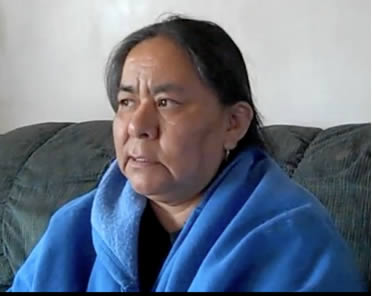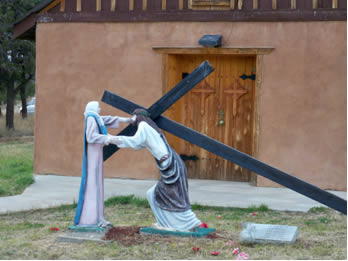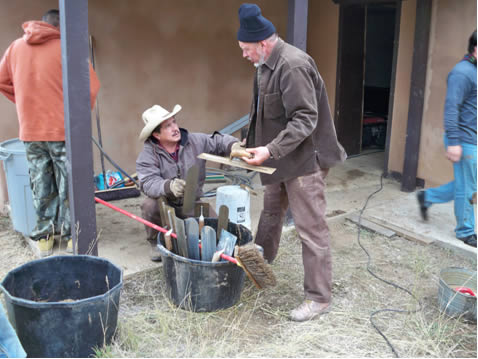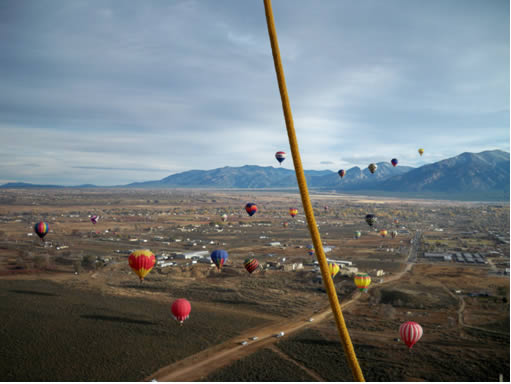The howl of high plains crosswinds hounds me all the way from Tulsa to Amarillo. It’s 370 miles, a five and a half hour drive. I’m trying to reach Muse on my iPhone every forty-five minutes. I leave four answering machine messages and four text messages without getting a reply. My Smart Car gets blown around from lane to lane like a patch of tumbleweed as I try to drive and touchpad at the same time.
The tallest object on the table top flat rural landscape is the cross at Groom, Texas. I can see it from twenty miles away on Interstate 40. Constructed by the right wing Cross of Our Lord Jesus Christ Ministries, it’s 190 feet high, all white and made of beveled steel. The base of the cross is surrounded by a score of slightly larger than life size bronze monuments depicting Jesus carrying a cross up Mount Calvary.
I feel like I’m in a modern day remake of “The Last Temptation of Christ.” The crucifixes in the middle of nowhere are the latest reminder of the cross I have to bear since I got accused of being a philanderer, of which I’m guilty, and being a pervert of which I’m not guilty, dammit.
Okay, I succumbed to temptation with Patsie. And it was wrong. I was a cad. So crucify me. There’s a growing body of evidence based on advances in neuro-science that suggests bio-chemistry endows virtually every male with voracious sexual appetites. (That even sounds nasty, doesn’t it? A “growing body” using “advances” to justify “appetites.” I mean, hey!)
Several months before embarking on my road trip, I actually underwent a so-called functional Magnetic Resonance Imaging (fMRI) test inside a metal tube at Princeton University. It was part of an experiment exploring how and why people make irrational economic decisions. I was presented with opposing images of stacks of coins inviting me to choose between short term and long term rewards.
Specifically designed fMRI tests are also used for mapping brain activity when subjects are presented with sexual images. According to some recent studies, male brains have two and a half times more space devoted to sexual drives. Men report wanting an average of 14 sex partners during their lifetime, where women say they want only one or two. What if both genders actually got what they wished for? What if their desired partner quotas were reversed? What if a frog had wings? Then it wouldn’t bump its ass when it hopped!
You don’t need an fMRI or a NOW membership to understand why feminist critics warn that attributing male behavior solely to testosterone and other hormones provides a ready excuse for all sorts of misbehavior. I haven’t tried to discuss neuro-science with Muse. Not that it would make much difference. She doesn’t seem to be in the mood to rationalize, only to emote. That may or may not be a function of the estrogen marinating her brain.
During a pit stop for gas and 5 Hour Energy Drink, I review the three emails I received from her before I beat it out of Tulsa. They’re not exactly encouraging. I can’t help noticing that the first of them is also unusually fluent with no Germ-English words and few awkward grammatical constructions. I later learn that she spent over two hours writing and rewriting it.
“You used to be my friend, my lover, my coach, my baby, my partner, and you taught me so much,” she writes in email number one. “In our best times we were flying so high and seemed invincible. Now the ground is shaky and there is no terra firma in sight. I tried to come to term with your edginess that turned more and more to anger. I am sure I made colossal mistakes as well. I tried to find fault in myself, but the magic was already gone.
“The final blow was when I find out you are actively pursuing other women,” email number one continues. “All this time, I had many chances to be with some great men, some richer and some younger than you, and I blew everybody off. How short sighted of me. I am certainly changing that attitude. I did not want to take the high moral ground, and judge you or accuse you or condemn you. But my heart does not want to cooperate. I don’t think a woman can change a man. One can only exchange them or leave. My pride is stronger than my love for you, and I loved you so very much.”
Email number two features photos of Muse standing on a snowy slope next to a single engine plane with ski runners attached to the landing gear. The third email, evidently forwarded to me accidentally on purpose, consists of a trail of messages written in German. Best I can translate, she plans to meet some guy named Alfie in Venice for “wiedervereinigung,” which literally means “reunification.”
Is it pure coincidence that reunify rhymes with crucify? Hell, do I know. In email number one, Muse finally said she loved me, though in past tense. As for the present and future, I can only seek solace in the existential philosophy of Albert Camus that inspired my road trip in the first place:
“God is deceitful,” Camus proclaimed in The Rebel, adding, “The whole world (myself included) is deceitful.”
###
Amarillo literally reeks of existentialism, as well as cow patties, horse manure, sulphur, fast food, gasoline, diesel, and human bullshit. An overgrown truck stop of 200,000 people on the former Route 66, it is the home of the American Quarter Horse Association, the Texas Cattle Feeders Association, Stanley March 3’s Cadillac Ranch, the world’s largest helium deposits, and the nation’s only nuclear assembly plant.
The name Amarillo means “yellow” in Spanish. The proper pronunciation is “Ah-mah-REE-yoh,” but redneck railroad workers insisted on saying “Am-ah-RILL-oh.” Buddy of mine who’s a ranching dynasty scion calls it “Moon Base Alpha.” Another buddy who’s long since moved to Austin claims the Texas Panhandle breeds insanity among children of the economic elite.
“There’s something about growing up out there in the flatland that keeps you content in the desolation of a cultural void or cultivates a creative side that sometimes goes crazy,” he says. “Rich kids I knew in Houston and Dallas still conducted themselves with a certain amount of decorum in front of their parents even as they were messing up behind the scenes. The rich kids I knew in Amarillo went out of their way to be social misfits.”
I’m planning to spend three days in Amarillo catching up on my writing and devising a way to repair my relationship with Muse. The rattle of eighteen wheelers passing by my La Quinta on Interstate 40 seems to match my alienated mood. Within twenty-four hours, however, I learn that the second best restaurant in town is Macaroni Joe’s, the most popular nightspot is the local Hooter’s, and the washing machine at my motel is busted.
In the spirit of Camus, I refuse to be what I am -- a man-o-pausal poke on Moon Base Alpha -- and take off for Taos, New Mexico. Although it’s another five and a half hour drive, I’m anxious to test the late Jim Morrison’s proclamation that, “The West is the best. Get here and we’ll do the rest.” The landscape changes from high plains to high desert to southern Rocky Mountains as I pass through Tucumcari, Santa Rosa, Las Vegas, Sapello, Mora.
I sense that the film script of my road trip is changing from a Biblical saga to a classic western. This is Indian country overrun with cowboys and Mexicans. If the backdrop is starkly different, the central story line is still the same. It’s about man’s inhumanity to man in general, and the war between the sexes in particular.
###
Taos Pueblo is a three-story adobe pyramid slouched in the shadows of Taos Mountain, which hosts both an upscale ski resort and the sacred waters of Blue Lake. Dating back over one thousand years, the pueblo is North America’s oldest continuously occupied residential structure. Much of it is crumbling, and most of the 1900 people in the tribe live in other homes on and off the 95,000 acre reservation.
I’m greeted outside the main gate by Bernadette Track, a local school district administrator who belongs to the tribe. At age 60, Bernadette has finely etched cheekbones and fiery brown eyes. Dressed in cowboy boots, jeans, and a green sweater, she still carries herself with the lithe grace of the professional dancer she was decades ago, but she’s wearing a blue shawl over her head.
“The woman of this pueblo are like women in Iraq who have to wear burkas,” Bernadette informs me. “Before we go out, we have to put on our shawls.”
That remark sets the tone for a rare inside look at the notoriously secretive Taos Pueblo tribe from the point of view of dissident females.
I follow Bernadette past the “No Tourists Allowed” signs into her mother’s apartment on the ground floor of the pueblo. With Bernadette’s permission, I turn on my Flip camera. The apartment consists of a single room with white painted adobe walls with a few tables and chairs. There is no toilet, no running water, no electricity.

“We try to keep it up, but you can see this isn’t the kind of place anyone would want to live in this day and age,” Bernadette says lighting some candles.
I’ve already surmised that Taos Pueblo revenues must be relatively meager compared to those of tribes that own huge casinos in Connecticut, Florida, and other states. The casino located outside the gates of the pueblo has only a few dozen slot machines, no table games, and no liquor service. Given the cold winters, revenues from walk around tourist traffic must come mainly in summer months. Even so, it would seem that restoring the pueblo infrastructure would be a high fiscal priority.
“Nobody knows where the money goes, that’s the problem,” Bernadette says. “The tribe is run by a small group of men who control everything. Women are usually not allowed in tribal meetings. And when we are allowed, all we can do is sit and listen.”
The following evening, I meet Bernadette and Dakota Star, age 28, at a home off the reservation owned by Glenda Concha, a feisty septuagenarian, and her daughter Iris Grubbs, a 22 year old student.
“Before the Spanish arrived in the 17th Century, Taos Pueblo was a matriarchal society,” Iris says. “The women took care of everything around the homestead, and the men were protectors and hunters. But when the Spanish came, they put the men in power, and everything changed from there.”
The Taos Pueblo tribe periodically revolted against their Spanish occupiers, and later, their American governor. But by the 20th Century, joblessness and alcoholism supplanted rebelliousness. With the approval of the Bureau of Indian Affairs, the tribe instituted its present political structure consisting of a governor of internal matters, a war chief of external relations, and an all-male tribal council.
Bernadette claims Taos Pueblo has always been more conservative and more hostile toward outsiders than other Native American tribes. “My father was a Sioux from South Dakota, and an army veteran in World War II,” she recalls. “After he married my mother and came down here to Taos Pueblo, they put him in jail because he wasn’t a member of the tribe. After they eventually let him out, he saw all the women in shawls, and he thought he was seeing ghosts.
“The tribe wants to control everything, including the way we look,” she adds. “I have a college degree. I have more education than all of the governor’s staff and I will never have a say. It’s not fair.”
Glenda complains that the tribal leaders refuse to share whatever wealth they do have. “The only money we get is around Christmas time, what they call a gift,” she says. “It’s a meager amount, $50, $100 if we’re lucky. And to get our money we have to put on our shawls and wait our turn in line.”
Iris opines that the most viable route to reform involves a Catch 22 type clause in the official relationship between Taos Pueblo and Washington. “The fix for what’s going on in our tribe is for the federal government to come in and do an audit,” she says. “But the rule is if any corruption or misuse of funds is found, we will be stripped of our sovereignty as a tribe.”

Next morning, I return to Taos Pueblo in hopes of discussing the dissident women’s grievances with tribal governor Ruben Romero. He refuses to be interviewed on camera unless I present their statements in writing. Tribal secretary Lewis Zamora candidly admits off camera that Taos Pueblo is a “paternal society.”
The male stonewalling pisses me off. My grand pappy John Sevier may have had much too much Indian blood on his hands, but just as I counseled Muse not take the rap for Hitler, I refuse to be take the blame for my ancestors’ sins. Male or female, if you want respect from others, you have to give respect to others.
I shoot a closing stand up in which Bernadette, and her friends remove their shawls and brandish my spare Flip cameras. I buy a fifth Flip at the local Wal-Mart, and give it to them so they can document future incidents of gender discrimination. After editing the video, I instruct my new web host, Andy, to post it on YouTube and www.harrywordofhurt.com. It’s titled “TAOS PUEBLO WOMEN ON THE WARPATH: Harry Gives Them Flips.”
###
Muse, meanwhile, is giving me fits. Correction: she is giving me nothing at all. I call. I text. I email. I get no response. Over the next two days, my voice mail messages grow increasingly plaintive and pathetic.
Day One, Message One: “Hi, it’s me. Listen, I’m so, so sorry. About everything. Please call me back.”
Day One, Message Two: “Hi, it’s me again. I’m in Taos, New Mexico. Working really hard. I’m sure you’re really busy, too, Call me back when you can. Bussi.”
Day One, Message Three: “Hi, I don’t hear back from you so I try one more time. Going to bed now. Guess it’s real late where you are. Call me in the morning. I’ll be up early. Guten nacht.”

Day Two, Message One: “Hallo, it’s me. I call and I call. Why don’t you call me back?”
Day Two, Message Two: “Ja, hi. I miss you so much. Can’t we vergeben und vegessen? Forgive and forget? Bitte. Please. I wish you would call me back.”
Day Two, Message Three: “Ja, hi. Maybe you don’t have cell phone service where you are. Sometimes the reception here is lousy. I’ve been sending you emails, too. Did you get them? Please let me know. Danke.”
Day Two, Message Four: “Ja, hi, again. Look, we really have to talk. This is getting ridiculous. I know I made a mistake. It will never happen again. I swear. Just give me one more chance. Please.”
Day Two, Message Five: “Okay, I call you back one more time before I go to bed. Maybe you are lighting a candle for us in a little chapel in the Alps. More likely, you are out parting at some club in Salzburg. Anyway, in case you’re interested, I have to saddle up and hit the road again. I won’t be in Taos for awhile. I’m spending tomorrow night at a friend of a friend’s house near the Sangre de Christo Mountains. That means Blood of Christ. My heart bleeds for you. Bussi.”
###
My western and Biblical sagas converge at a Penitente Brotherhood in Rio Arriba County. Huddled on a pine-studded mountaintop about 100 miles west of Taos, the community of 400 people boasts a post office, clusters of wood framed houses, and a pair of religious features unique to the Penitente -- a two-room sacred meeting house made of adobe called a morada, and a steeply inclined pathway commemorating the Stations of the Cross.
The Penitente of Rio Arriba County, one of several brotherhoods scattered about New Mexico, are descended from 19th Century settlers scorned by the resident Spanish aristocracy as low class. After Mexico won independence, their assigned Catholic priests fled back to Europe. Isolated by geography and society, the men began to serve as secular priests, observing self-flagellation rituals and reenactments of the Crucifixion.
My entree to the Pentitente comes through Quentin Wilson, the gray-bearded director of the adobe construction program at Northern New Mexico College, and his protege Jim Harford, a friend of a friend back east. Our mission is to help the Penitente rebuild the floor of the morada, which must be made of mud in keeping with their beliefs about the importance of maintaining connection with Mother Earth.
I can tell right off there’s not much dough in adobe, much less an employment opportunity for me. But Quentin notes that adobe construction is cheap, accessible, and empowering, a potential fallback come the apocalypse.
It’s the one material you can build and build, and governments can’t stop you,” he says. “They can take away your shovel. They can take away your wheelbarrow. But as long as you’ve got two hands, you can keep on building. And there’s never any shortage of dirt.”
The leader of the Penitente turns out to be a forest ranger in his mid-thirties named Kenny. He’s dressed in a camouflage cap and hunting jacket rather than the priestly robes I expect. He’s accompanied by fifteen other men, most of them farmers, fire fighters, or carpenters, wearing jeans and cowboy hats. They’ve assembled an impressive array of wheelbarrows, mixers, and trowels in front of the morada.
“We’ve got a couple of different kinds of dirt here,” Kenny informs Quentin. “What we’d like to know first off is which one you prefer.”
After a bit of testing, Quentin concludes that the best dirt for the floor is 30 percent clay and 70 percent sand. For the ensuing three hours, we repeat three steps: mix dirt with water, transfer mud in wheelbarrows, spread mud with trowels.
The rectangular interior of the morada is adorned with somber drawings of Christ in a Crown of Thorns. But the Pentitente do their chores with the irreverent banter heard at a corner cantina. We break for a lunch of fresh venison, chiles, and flower tortillas prepared by as yet unseen women and served from the tailgate of a pickup. I trade barbs with a mustached fireman named Bernardo about which one of us is doing the least amount of work.
“You should be around tomorrow if you want to do some real work,” he suggests. “The vet’s coming down to give pregnancy tests to the cows.”
###
Upon returning to Taos, I feel like I’ve died and gone to Halloween, which it happens to be. I'm staying at the San Geronimo Lodge, which features in-room fireplaces, a peace walk, and fabulous home cooked breakfasts. There’s live music and a costume contest at the Taos Inn. I celebrate by going on a shopping spree worthy of the world’s girliest girly-man at a western wear store called Taos Cowboy. My purchases include a brown leather jacket with fringed sleeves and fake deer vertebrae embroidery, a black snap button shirt with gold pocket stitching, brown and turquoise Durango cowboy boots, and an extra broad brimmed grey cowboy hat with a beaded band.

I don a pair of wrap around shades, and dub myself “The Lone Stranger.”
No way I’m going to win the Halloween costume contest. My drugstore cowboy outfit is everyday attire for many if not most local yokels. I’d blend in even better if I had a ponytail like half the other guys who frequent the Taos Inn. And that’s just one of many reasons I’m loving Taos as much if not more than the goofiest gringo hippie who ever jingle-jangled down the main drag.
I love the sweet smell of pinon logs perfuming the air. I love that there’s gourmet restaurants like Joseph’s Table, Downtown Bistro, and Graham’s Grille alongside Mexican food dives and an adobe McDonald’s. I love the margaritas at the Adobe Bar. I love my $100 a night room at the San Geronimo Lodge with a fireplace, a porch, and a view of Taos Mountain. I love riding in hot air balloons. I love Rio Grande Gorge and the spaced-out subdivision of eco-friendly Earthships made of used tires, discarded beer cans, and compressed dirt.
The only bummer is that I still love Muse, but apparently, the feeling is no longer mutual. Or so she says in so many words when I finally reach her on a transAtlantic cell phone call.
“How’s my girl?” I ask. “I have been calling and calling and texting and emailing.”
“Ja, I know.”
“Why don’t you call me back?”
“I am in Austria. With old friends.”
“I thought you were going to Venice.”
“That makes you jealous?”
“Maybe.”
“It should.”
“Yeah? You are seeing some Austrian aristo?”
“Ja. But we don’t go to Venice.”
"Why not?”
“My mother was getting better, then she gets sick again. So I stay in Salzburg. I am being treated very well here. Very, very well.”
“That’s nice. I like my girl to be treated very, very well.”
“You don’t seem to understand.”
“Understand what?”
“I’m not your girl anymore.”
Photograph Captions and Credits: 1. Glenda Concha of Taos Pueblo tribe (HH3). 2. Penitente Church in Ri Arriba County, NM (HH3) 3. Quentin Wilson and Penitente community resident in front or morada. (HH3) 4. Taos balloon rally (HH3)
